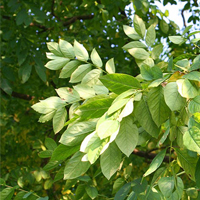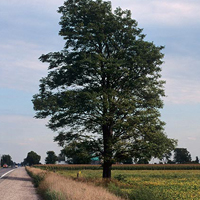Kentucky Coffee-tree (Species at Risk)
Scientific name: Gymnocladus dioicus


Photo credits: Allen Woodliffe
Status
Threatened in the following geographic areas:
- the County of Elgin
- the County of Essex
- the County of Lambton
- the County of Middlesex
- the County of Norfolk
- the County of Oxford
- the Municipality of Chatham-Kent
“Threatened” means the species lives in the wild in Ontario, is not endangered, but is likely to become endangered if steps are not taken to address factors threatening it.
The species is classified as not at risk in all other jurisdictions in Ontario.
Date added to the Species at Risk in Ontario List
The Kentucky Coffee-tree was already assessed as at-risk when the Endangered Species Act took effect in 2008.
In 2021 the Committee on the Status of Species at Risk in Ontario classified the species as threatened in its native Ontario range, which includes Elgin, Essex, Lambton, Middlesex, Norfolk and Oxford Counties and the Municipality of Chatham-Kent. Kentucky Coffee-tree is not classified as at risk in all other jurisdictions of Ontario.
Read the most recent assessment report (PDF).
What it looks like
Kentucky Coffee-tree grows 15 to 25 metres high. The leaves are as big as 60 by 90 centimetres, the largest leaves of any Canadian tree. They are twice compound, divided into many, small bluish-green leaflets. The flowers are greenish-white in colour.
The fruit is a hard, dark, leathery and bean-like pod, about 15 to 25 centimetres long. The fruit contains four to seven seeds and remains on the tree throughout the winter. Kentucky Coffee-tree may grow singly or in larger groups where multiple trunks emerge from the same root system.
Where it lives
Kentucky Coffee-tree is found in a variety of habitats, but grows best on moist, rich soil. Consequently, it is often found in floodplains, though it will tolerate shallow rocky or sandy soils.
It is shade-intolerant, and therefore grows along the edges of woodlots or relies on canopy openings in forests and woodlots.
The Kentucky Coffee-tree is rare throughout its range, which extends from the southern Great Lakes region east to New York in scattered localities, south to Oklahoma and Arkansas, and west to Kansas and Nebraska. In Canada, it is only found in southwest Ontario where it was documented at 20 locations in 2000.
Where it’s been found in Ontario
Native subpopulations of Kentucky Coffee-tree are restricted to southwestern Ontario, particularly:
- the County of Essex
- the County of Lambton
- the County of Middlesex
- the Municipality of Chatham-Kent
The extent of native subpopulations in Ontario represents approximately 3% of the global range of Kentucky Coffee-tree.
Extirpated subpopulations previously occurred in:
- the County of Oxford
- the County of Norfolk
- the County of Elgin
In addition to the native subpopulations that occur in southwest Ontario, Kentucky
Coffee-tree has been introduced throughout southern Ontario. Planted individuals have been reported throughout the Mixedwood Plains Ecozone (Ecoregions 6E and 7E), as far north and east as Ottawa.
What threatens it
Currently, the most significant threats facing Kentucky Coffee-tree subpopulations in Ontario are:
- fire suppression, which leads to the closure of the forest canopy, creating conditions that restrict the grown or reproduction of Kentucky Coffee-tree
- high densities of Double-crested Cormorant nesting on Lake Erie islands, which leads to defoliation from nesting and roosting, and acidification of soils
- the possibility of prolonged flooding in subpopulations on islands or at shorelines of lakes Erie and St. Clair, leading to mortality of plants
Other threats to the species include:
- droughts
- ecosystem modifications
- roads and railroads
- logging and wood harvesting
Action we are taking
This species and its habitat are protected under Ontario’s Endangered Species Act, 2007 (ESA).
The ESA also requires us to prepare recovery guidance for threatened species such as Kentucky Coffee-tree.
All species listed on the Species at Risk in Ontario List may be eligible for consideration for government funding through the Species at Risk Stewardship Program.
Recovery strategy
A recovery strategy advises the ministry on ways to ensure healthy numbers of the species return to Ontario.
Read the executive summary and full document (December 13, 2017)
Government response statement
A government response statement outlines the actions the government intends to take or support to help recover the species.
Read the government response statement (December 21, 2018)
Review of Progress
A review of progress made toward protecting and recovering a species is required no later than the time specified in the species’ government response statement, or not later than five years after the government response statement is published if no time is specified.
Read the report on progress towards the protection and recovery of 11 species at risk, including Kentucky Coffee-tree (2023).
Habitat protection
General habitat protection - June 30, 2013
What you can do
Report a sighting
Submit your observations of species at risk to the Natural Heritage Information Centre (NHIC), which is Ontario’s conservation data centre. Join the centre’s Rare Species of Ontario project in iNaturalist, an online plant and animal identification app, to quickly and easily submit your observations.
Volunteer
Volunteer with your local nature club or provincial park to participate in surveys or stewardship work focused on species at risk.
Be a good steward
- Private landowners have a very important role to play in species recovery. If you find species at risk on your land, you may be eligible for stewardship programs that support the protection and recovery of species at risk and their habitats, such as the Species at Risk Stewardship Program.
- Invasive species seriously threaten many of Ontario’s species at risk. To learn what you can do to help reduce the threat of invasive species, visit:
Report illegal activity
Report any illegal activity related to plants and wildlife to
Quick facts
- Part of the Latin name for the Kentucky Coffee-tree (Gymnocladus dioica) means "naked branch", because this tree spends up to nine months of the year without any leaves.
- The only other species in the genus of Kentucky Coffee-tree is a tree that grows only in China.
- Because no native herbivores consume the toxic Kentucky Coffee-tree seeds – and since elephants devour similar seed pods in great quantities – it has been hypothesized that the now-extinct Mastodon may have consumed Kentucky Coffee-tree pods. In fact, Kentucky Coffee-tree may have evolved its unique seeds, which seem unpalatable to native animals, specifically for Mastodon-assisted dispersal.